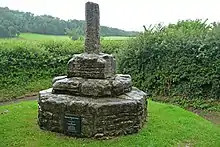Dunster Butter Cross
The Butter Cross in Dunster within the English county of Somerset is a Grade II* listed building and ancient monument.[1][2][3] The cross was originally erected in the late 14th or early 15th century in the main street, and was moved to its current site in the late 18th or early 19th century. Although the head of the cross is missing, the shaft and socket stone are original. The cross is in the care of English Heritage and is managed by the National Trust.
| Butter Cross | |
|---|---|
 | |
| Location | Dunster, Somerset, England |
| Coordinates | 51°11′6″N 3°26′57″W |
| Built | 15th century |
Listed Building – Grade II* | |
| Official name | Butter Cross |
| Designated | 22 May 1969[1] |
| Reference no. | 1345602 |
| Official name | Butter Cross at Dunster |
| Designated | 18 March 1996 |
| Reference no. | 1014409 |
 Location of Butter Cross in Somerset | |
History
The name Buttercross originates from their location in market places, where people from neighbouring villages would gather around the market cross to buy locally produced products.[4] The fresh produce was laid out and displayed on the stepped bases of the cross. The market in Dunster attracted people from surrounding villages and towns as far away as Taunton and Bodmin.[5] The Dunster Butter Cross was erected in the late 14th or early 15th century and originally stood in the High Street, possibly at the southern end of the high street, near the Yarn Market.[6] A cross, which was later known as the high cross, was recorded in 1461; by 1689 it was known as the Butter Cross.[4]
It was moved to its current location on St George's Street at the edge of the village, although the date when this was done is unclear. The site where the cross now stands was levelled in 1776 by workmen, paid by Henry Fownes Luttrell, and it may have been on this occasion that the cross was moved.[7] An alternative local tradition is that it was moved in 1825, although a drawing by J. M. W. Turner made in 1811 suggests it was in its present position by then.[8]
The cross is in the care of English Heritage and is managed by the National Trust.[9][10]
Architecture
The cross comprises a shaft with a plinth and socket stone forming the base. The octagonal base and polygonal shaft have survived, but the head of the cross has been lost.[1][11] It stands on a small area of raised ground. The socket stone is 0.85 metres (2 ft 9 in) wide and 0.5 metres (1 ft 8 in) high. The surviving shaft is 1.1 metres (3 ft 7 in) high and changes from square to octagonal as it rises.[2] There is an inscription on the northern face which says "WC, 1871, WS" recording a restoration.[2]
See also
References
- Historic England. "Butter Cross – listed building (1345602)". National Heritage List for England. Retrieved 15 June 2014.
- Historic England. "Butter Cross at Dunster – ancient monument (1014409)". National Heritage List for England. Retrieved 15 June 2014.
- "Butter Cross, Dunster". Exmoor Historic Environment Record. Exmoor National Park.
- Siraut, Mary. "Dunster Market Place and its Buildings". Victoria County History. Retrieved 17 April 2015.
- "Dunster's market and fair". VCH Explore. Victoria County History. Retrieved 15 June 2014.
- Maxwell Lyte, H. C. (1880). "Dunster and its Lords" (PDF). The Archaeological Journal. 37: 285. doi:10.5284/1018054.
- "The Butter Cross at Dunster". Taunton Courier, and Western Advertiser. British Newspaper Archive. 26 September 1942. Retrieved 7 July 2014.
- "Dunster: The Butter Cross, St George's Church, the Castle and Conygar Tower". Tate. Retrieved 15 June 2014.
- "History of Dunster Butter Cross". English Heritage. Retrieved 5 April 2015.
- "Butter Cross, Dunster". Somerset Historic Environment Record. Somerset County Council. Retrieved 3 February 2015.
- "History and Research: Dunster Butter Cross". English Heritage. Retrieved 8 June 2014.